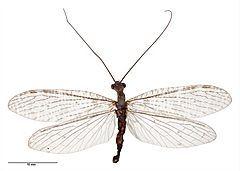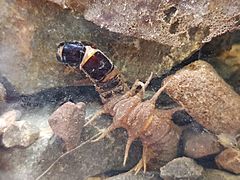Archichauliodes diversus facts for kids
Quick facts for kids Archichauliodes diversus |
|
|---|---|
 |
|
| Adult male | |
 |
|
| Larva | |
| Scientific classification | |
| Kingdom: | |
| Phylum: | |
| Class: | |
| Order: | |
| Family: | |
| Genus: |
Archichauliodes
|
| Species: |
A. diversus
|
| Binomial name | |
| Archichauliodes diversus Walker, 1853
|
|
Archichauliodes diversus is a special insect found only in New Zealand. It belongs to a group called Chauliodinae, which are known as fishflies. Even though it's sometimes called the New Zealand dobsonfly, it's not a true dobsonfly.
When it's young, in its larval form, people often call it a toe-biter because of its strong jaws. Its Māori name is puene. This insect is native to New Zealand. It's the only type of fishfly you'll find there, making it quite unique!
Contents
What Does the Toe-Biter Look Like?
Larva: A Big Freshwater Insect
The larvae of Archichauliodes diversus are some of the largest freshwater insects in New Zealand. Their head and the part behind it, called the thorax, are black and flat. They have very big, strong jaws called mandibles.
These larvae are tough creatures. Their heads and thorax are very hard and strong. Their abdomen (the back part of their body) is long and light in color. It has eight pairs of gill-like tentacles that help them breathe underwater.
Like other fishfly larvae, they have special hooks at their tail end. They use these hooks to hold onto rocks or other things in the water. This stops them from being washed away by the current.
Where Do Toe-Biters Live?
Finding A. diversus in New Zealand
Archichauliodes diversus is found only in New Zealand. It lives all over both the North and South Islands. You can often find it in streams across the country.
This insect prefers streams with clean water. It likes places with stony or hard bottoms, especially in areas with bushes or farmland. It also enjoys streams where trees or plants hang over the water. This gives them shelter and good places to live.
Life Cycle of the Toe-Biter
From Egg to Adult Insect
Archichauliodes diversus spends most of its life underwater as a larva. This can last for two to five years! The adult insects, however, live on land near the streams.
This species has a very interesting life cycle with many stages. It changes a lot in size and looks as it grows. It goes from an egg, to a larva, then a prepupa, a pupa, and finally an adult.
Nocturnal Habits
A. diversus is a nocturnal animal. This means it is most active when the sun goes down and during the night.
The Egg Stage
The first stage is the egg. When first laid, the eggs are light yellow and shaped like tiny cylinders. They turn dark brown when they are exposed to the air. This egg stage lasts for about 30 days.
The Larval Stage
When they hatch, the larvae are very small, about 2.2 millimeters long. They can grow much bigger, up to about 38.5 millimeters! They have eight pairs of "gills" along their abdomen, which help them breathe. This is the only stage where the insect eats. You can find larvae all year round.
The Prepupal Stage
In the third stage, called the prepupa, the larva moves out of the water. It goes towards the edge of the stream or river banks. This stage happens from early July to late January and lasts about 15 weeks. The prepupa needs the soil to be wet for the next stage to begin.
The Pupal Stage
The pupal stage lasts about 20 to 24 days. The time can be different for males and females, with males taking a bit longer. This stage occurs from late October to February. The pupa looks a bit like the adult but is bigger and has wings that aren't fully grown. Its color changes from pale to dark brown in just a few hours or days.
The Adult Stage
The final stage is the adult, also called the "imago." Adults only live for a short time, usually about 6 to 10 days. During this time, they mostly rest in nearby trees. Before they die, the female lays hundreds of eggs. She lays them in groups on trees, bushes, and rocks near the water.
What Do Toe-Biters Eat?
A Predator in the Water
Archichauliodes diversus larvae are predators. This means they hunt and eat other animals. They use their large, strong jaws, which have tiny teeth-like edges, to catch other small creatures that live in the water.
They especially like to eat mayflies, such as Aoteapsyche and Atalophlebioides. They are most active at night. They often hide and wait for prey in fast-moving parts of the stream. Here, the water stirs up food, making it easier to catch. While mayfly larvae are their main food, they will eat almost anything smaller than themselves, even other toe-biters!
These insect predators compete with fish for food. They both eat many of the same small water animals, like mayfly larvae, which are an important food source for fish in streams.
Who Eats the Toe-Biter?
Natural Predators and Threats
Several animals like to eat Archichauliodes diversus. Fish such as Brown trout and Galaxiidae (which includes Galaxias fish) are known to prey on them.
The larval stage is also at risk from other insect larvae. These include caddisfly larvae and stonefly larvae. When the toe-biter is in its pupal or prepupal stages, spiders and beetles can be a threat. Birds also eat them.
The biggest danger to this species comes from humans changing their habitat. When people remove bushes and trees that hang over waterways, it harms the toe-biter. These plants are a very important part of their life cycle.

